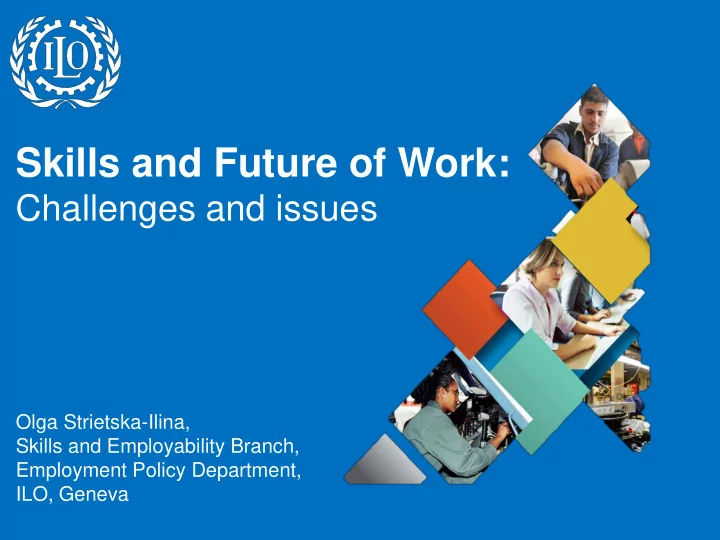

Skills and Future of Work: Challenges and issues Olga Strietska-Ilina, Skills and Employability Branch, Employment Policy Department, ILO, Geneva
This presentation Some global drivers of change Impact on skills What it means for skills development Based on work which contributes to the current debate on FoW
Driver of change: Technology and innovation The pace of change Not only robotisation The internet of things 3d printing /AM Infrastructure innovation projects Interdisciplinarity (e.g. biotechnology)
The wrong question: how many jobs are at risk? Half in advanced economies (Frey, Osborne 2013), Asia - around 56% (ILO, 2016) Some argue – potentially all Automatable ≠ will be automated Not likely any time soon in developing countries Opportunity : one tech job generate 5 indirect jobs! Tasks and skills that change
Technology and innovation: Skills impact Which skills will secure jobs? STEM skills at all levels ICT and coding skills Skills that help to adopt, operate and maintain technologies Skills that help to create a business Employment growth by skill-level of occupations case, market and manage 2000-2021 technologies adoption 250000.0 200000.0 Creativity 150000.0 Social skills (interaction, care) 100000.0 Non-automatable high-manual dexterity 50000.0 0.0 tasks Low income Lower-middle Upper-middle High income income income Mitigate the negative impact of job High Medium Low losses Source: ILO modelled estimates, 2016
Driver of change: Demographic change Slowdown in working-age population growth But the pace of labour force growth outstrips job creation 71 million young people worldwide are unemployed 40 MIO people enter labour market annually: between now and 2030 - 600 MIO new jobs needed to keep current employment rates (majority of them in Asia and Sub-Saharan Africa) (WDR 2013) The developed world is Labour force projections (thous.) (ILO modelled estimates 2016) ageing fast 4000000 Workers of the future are 3500000 older workers 3000000 2500000 Labour shortages are 2000000 1500000 expected 1000000 500000 0 2000 2001 2002 2003 2004 2005 2006 2007 2008 2009 2010 2011 2012 2013 2014 2015 2016 2017 2018 2019 2020 2021 Developed Developing
Demographic change: skills impact The global competition for talent Higher global mobility of labour expected Growing skills mismatches and economy slowdown – result of aging Lifelong learning Activation measures (older workers, women) Shortage of labour predicted, especially trained in upper secondary TVET and tertiary education degrees Skills availability is a challenge to attract investors and create jobs 5/15/2017 7
Driver of change: Globalization and trade GVCs, redistribution of work, offshoring and Exporter Non-Exporter reshoring 30.0 Trade openness can promote economic growth 25.0 and employment creation 20.0 Exporting firms tend to be larger, more 15.0 productive and employ higher skilled labour 10.0 Skills are key for both quantity and quality of 5.0 export growth Key to economic diversification (new products 0.0 High Income Upper Middle Lower middle Low Income Income Income and services, markets, technologies) The dispersion of skill levels also affects countries' comparative advantage in trade Skills play a role of a buffer helping to reduce adjustment costs Offset the tendency of trade to drive increases in income inequality Key for companies’ ability to move up in the value chain
Globalization and trade: skills impact targeted skills training in skill intensive sectors that benefit from trade expansion (STED) targeted measures to mitigate unemployment and address equity (gender, youth, aging workers) policy coherence between trade and skills development core work skills (portable!) addressing specific skills such as marketing, compliance with standards and regulations, quality control, food safety, products labelling, product design and product development, supply chain management and procurement etc.
Other drivers Change in work organisation Mobility of labour Transition to environmental sustainbility and a low carbon ecnomy Educational attainment
Skills development systems Foundation skills. Basis for LLL! LLL and access – financing and incentivising employers and individuals. Core work skills – transferable and employability skills! Can’t be «tought». Not prioritised by systems. Having a profession increases employability. TVET – new universal basic? More role of the private sector to develop job specific skills? (but what about «virtual» workers?) Incentives for workplace learning. Role of MOOCs and digital learning platforms vs role of schools. Teachers ’ training! Are they ready for blended learning? Competency sandards and NQFs: the more advanced, the heavier. What will be the strategy of standardisation of learning outcomes? Future talent pipeline requires much more flexibility in skills delivery. Refashion modularised training?
Skills development systems A pressure on skill needs anticipation but is the task doable? Can real time / big data help? Foresight – a change management tool Social dialogue – the means to understand and mitigate the change Sectoral approaches: a way to establish a doalogue between the WoW and training ALMPs – low skilled, job seekers (beyond the unemployed!), disadvantaged groups Skills utilisation: measures to retain, recognise and attract talent go way beyond skills measures
A feedback loop Jobs Skills
Coordination!
ILO Skills Policy Framework The key role of the identification of skill needs in the dynamic framework of objectives of skills development policy for today’s labour market (reduce skills mismatch) and for tomorrow (prepare for technologies and industries with growth potential); Skills development itself could be an important driver of change if skills are an integral part of employment, industrial, technological, environmental and other policies Anticipating future skills needs is recognised as the first building block of the G20 Training Strategy
Thank you! “ When the winds of change blow, some seek shelter, others build windmills ” – an old Chinese Proverb 16
Recommend
More recommend